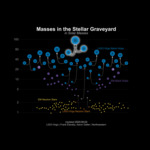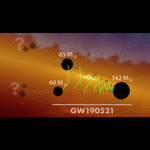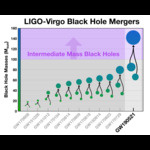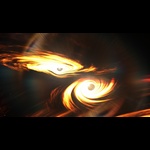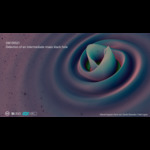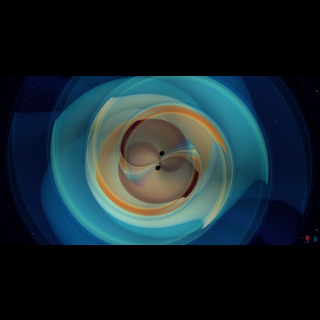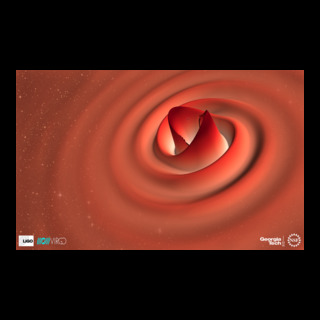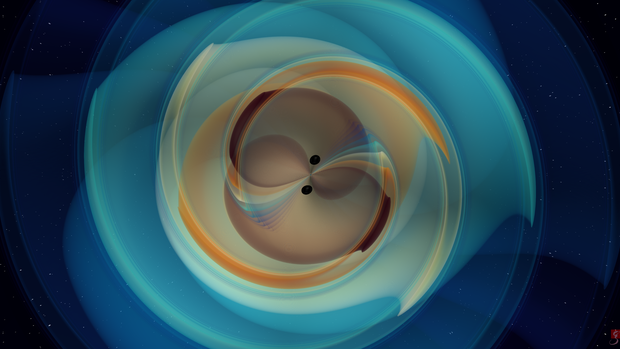
A still image from a numerical simulation of two black holes that inspiral and merge, emitting gravitational waves. The black holes have large and nearly equal masses, with one only 3% more massive than the other. The simulated gravitational wave signal is consistent with the GW190521 observation made by the LIGO and Virgo. (Credit: N. Fischer, H. Pfeiffer, A. Buonanno (Max Planck Institute for Gravitational Physics), Simulating eXtreme Spacetimes (SXS) Collaboration)
A “bang” in LIGO and Virgo detectors signals most massive gravitational-wave source yet
News Release • September 2, 2020
A binary black hole merger likely produced gravitational waves equal to the energy of eight suns.
For all its vast emptiness, the universe is humming with activity in the form of gravitational waves. Produced by extreme astrophysical phenomena, these reverberations ripple forth and shake the fabric of space-time, like the clang of a cosmic bell.
Now researchers have detected a signal from what may be the most massive black hole merger yet observed in gravitational waves. The product of the merger is the first clear detection of an “intermediate-mass” black hole, with a mass between 100 and 1,000 times that of the sun.
They detected the signal, which they have labeled GW190521, on May 21, 2019, with the National Science Foundation’s Laser Interferometer Gravitational-wave Observatory (LIGO), a pair of identical, 4-kilometer-long interferometers in the United States; and Virgo, a 3-kilometer-long detector in Italy.
The signal, resembling about four short wiggles, is extremely brief in duration, lasting less than one-tenth of a second. From what the researchers can tell, GW190521 was generated by a source that is roughly 5 gigaparsecs away, when the universe was about half its age, making it one of the most distant gravitational-wave sources detected so far.
As for what produced this signal, based on a powerful suite of state-of-the-art computational and modeling tools, scientists think that GW190521 was most likely generated by a binary black hole merger with unusual properties.
Almost every confirmed gravitational-wave signal to date has been from a binary merger, either between two black holes or two neutron stars. This newest merger appears to be the most massive yet, involving two inspiraling black holes with masses about 85 and 66 times the mass of the sun.
The LIGO-Virgo team has also measured each black hole’s spin and discovered that as the black holes were circling ever closer together, they could have been spinning about their own axes, at angles that were out of alignment with the axis of their orbit. The black holes’ misaligned spins likely caused their orbits to wobble, or “precess,” as the two Goliaths spiraled toward each other.
The new signal likely represents the instant that the two black holes merged. The merger created an even more massive black hole, of about 142 solar masses, and released an enormous amount of energy, equivalent to around 8 solar masses, spread across the universe in the form of gravitational waves.
“This doesn’t look much like a chirp, which is what we typically detect,” says Virgo member Nelson Christensen, a researcher at the French National Centre for Scientific Research (CNRS), comparing the signal to LIGO’s first detection of gravitational waves in 2015. “This is more like something that goes ‘bang,’ and it’s the most massive signal LIGO and Virgo have seen.”
The international team of scientists, who make up the LIGO Scientific Collaboration (LSC) and the Virgo Collaboration, have reported their findings in two papers published today. One, appearing in Physical Review Letters, details the discovery, and the other, in The Astrophysical Journal Letters, discusses the signal’s physical properties and astrophysical implications.
“LIGO once again surprises us not just with the detection of black holes in sizes that are difficult to explain, but doing it using techniques that were not designed specifically for stellar mergers,” says Pedro Marronetti, program director for gravitational physics at the National Science Foundation. “This is of tremendous importance since it showcases the instrument’s ability to detect signals from completely unforeseen astrophysical events. LIGO shows that it can also observe the unexpected.”
In the mass gap
The uniquely large masses of the two inspiraling black holes, as well as the final black hole, raise a slew of questions regarding their formation.
All of the black holes observed to date fit within either of two categories: stellar-mass black holes, which measure from a few solar masses up to tens of solar masses and are thought to form when massive stars die; or supermassive black holes, such as the one at the center of the Milky Way galaxy, that are from hundreds of thousands, to billions of times that of our sun.
However, the final 142-solar-mass black hole produced by the GW190521 merger lies within an intermediate mass range between stellar-mass and supermassive black holes — the first of its kind ever detected.
The two progenitor black holes that produced the final black hole also seem to be unique in their size. They’re so massive that scientists suspect one or both of them may not have formed from a collapsing star, as most stellar-mass black holes do.
According to the physics of stellar evolution, outward pressure from the photons and gas in a star’s core support it against the force of gravity pushing inward, so that the star is stable, like the sun. After the core of a massive star fuses nuclei as heavy as iron, it can no longer produce enough pressure to support the outer layers. When this outward pressure is less than gravity, the star collapses under its own weight, in an explosion called a core-collapse supernova, that can leave behind a black hole.
This process can explain how stars as massive as 130 solar masses can produce black holes that are up to 65 solar masses. But for heavier stars, a phenomenon known as “pair instability” is thought to kick in. When the core’s photons become extremely energetic, they can morph into an electron and antielectron pair. These pairs generate less pressure than photons, causing the star to become unstable against gravitational collapse, and the resulting explosion is strong enough to leave nothing behind. Even more massive stars, above 200 solar masses, would eventually collapse directly into a black hole of at least 120 solar masses. A collapsing star, then, should not be able to produce a black hole between approximately 65 and 120 solar masses — a range that is known as the “pair instability mass gap.”
But now, the heavier of the two black holes that produced the GW190521 signal, at 85 solar masses, is the first so far detected within the pair instability mass gap.
“The fact that we’re seeing a black hole in this mass gap will make a lot of astrophysicists scratch their heads and try to figure out how these black holes were made,” says Christensen, who is the director of the Artemis Laboratory at the Nice Observatory in France.
One possibility, which the researchers consider in their second paper, is of a hierarchical merger, in which the two progenitor black holes themselves may have formed from the merging of two smaller black holes, before migrating together and eventually merging.
“This event opens more questions than it provides answers,” says LIGO member Alan Weinstein, professor of physics at Caltech. “From the perspective of discovery and physics, it’s a very exciting thing.”
"Something unexpected"
There are many remaining questions regarding GW190521.
As LIGO and Virgo detectors listen for gravitational waves passing through Earth, automated searches comb through the incoming data for interesting signals. These searches can use two different methods: algorithms that pick out specific wave patterns in the data that may have been produced by compact binary systems; and more general “burst” searches, which essentially look for anything out of the ordinary.
LIGO member Salvatore Vitale, assistant professor of physics at MIT, likens compact binary searches to “passing a comb through data, that will catch things in a certain spacing,” in contrast to burst searches that are more of a “catch-all” approach.
In the case of GW190521, it was a burst search that picked up the signal slightly more clearly, opening the very small chance that the gravitational waves arose from something other than a binary merger.
“The bar for asserting we’ve discovered something new is very high,” Weinstein says. “So we typically apply Occam’s razor: The simpler solution is the better one, which in this case is a binary black hole.”
But what if something entirely new produced these gravitational waves? It’s a tantalizing prospect, and in their paper the scientists briefly consider other sources in the universe that might have produced the signal they detected. For instance, perhaps the gravitational waves were emitted by a collapsing star in our galaxy. The signal could also be from a cosmic string produced just after the universe inflated in its earliest moments — although neither of these exotic possibilities matches the data as well as a binary merger.
“Since we first turned on LIGO, everything we’ve observed with confidence has been a collision of black holes or neutron stars,” Weinstein says “ This is the one event where our analysis allows the possibility that this event is not such a collision. Although this event is consistent with being from an exceptionally massive binary black hole merger, and alternative explanations are disfavored, it is pushing the boundaries of our confidence. And that potentially makes it extremely exciting. Because we have all been hoping for something new, something unexpected, that could challenge what we’ve learned already. This event has the potential for doing that.”
This research was funded by the U.S. National Science Foundation.
Additional information about the gravitational-wave observatories:
LIGO is funded by the NSF and operated by Caltech and MIT, which conceived of LIGO and lead the project. Financial support for the Advanced LIGO project was led by the NSF with Germany (Max Planck Society), the U.K. (Science and Technology Facilities Council) and Australia (Australian Research Council-OzGrav) making significant commitments and contributions to the project. Approximately 1,300 scientists from around the world participate in the effort through the LIGO Scientific Collaboration, which includes the GEO Collaboration. A list of additional partners is available at https://my.ligo.org/census.php.
The Virgo Collaboration is currently composed of approximately 520 members from 99 institutes in 11 different countries including Belgium, France, Germany, Hungary, Italy, the Netherlands, Poland, and Spain. The European Gravitational Observatory (EGO) hosts the Virgo detector near Pisa in Italy, and is funded by Centre National de la Recherche Scientifique (CNRS) in France, the Istituto Nazionale di Fisica Nucleare (INFN) in Italy, and Nikhef in the Netherlands. A list of the Virgo Collaboration groups can be found at http://public.virgo-gw.eu/the-virgo-collaboration/. More information is available on the Virgo website at http://www.virgo-gw.eu.
Related
GW190521: A Binary Black Hole Merger with a Total Mass of 150 M_o (discovery paper). Published in Phys. Rev. Lett. 125, 101102 (2020)
Properties and Astrophysical Implications of the 150 Msun Binary Black Hole Merger GW190521. Published in Astrophys. J. Lett. 900 L13 (2020)
GW190521 Parameter Estimation Samples and Figure Data
GW190521 announcement at the LSC website
Virgo press release on GW190521
Media Contacts
Caltech
Whitney Clavin
wclavin@caltech.edu
MIT
Abigail Abazorius
abbya@mit.edu
617-253-2709
Virgo
Livia Conti
livia.conti@pd.infn.it
NSF Media Affairs
media@nsf.gov
703-292-7090


